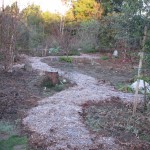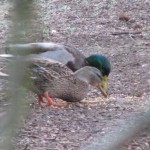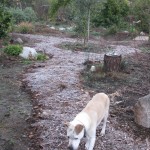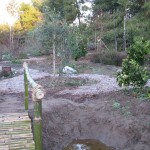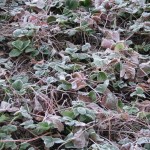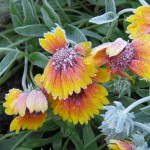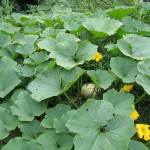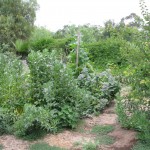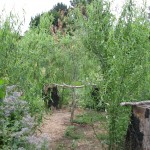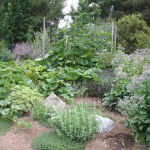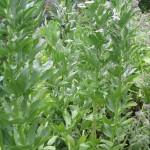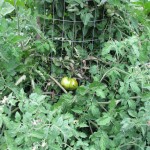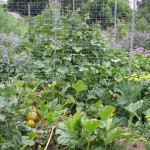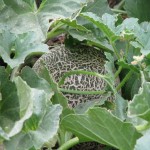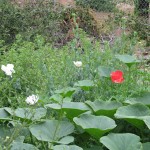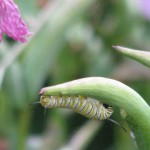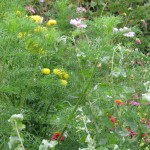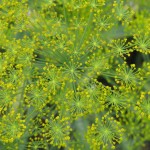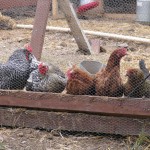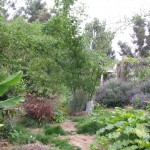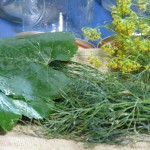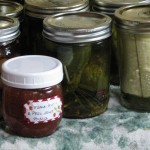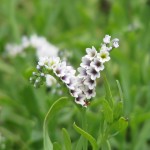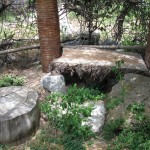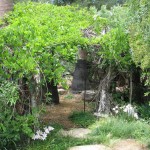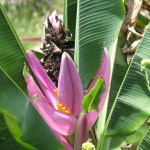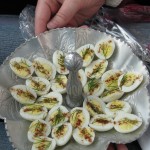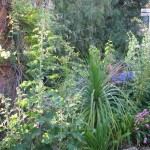- Animals, Chickens, Compost, Gardening adventures, Hugelkultur, Permaculture and Edible Forest Gardening Adventures, Soil, Worms
Strawberry-flavored Hugelkultur, Please
A few months ago my daughter and I thinned out the raised strawberry bed.

Way too many plants. I planted the extra strawberries under the passionvine arch,
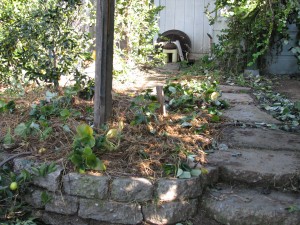
Under the passionvine trellis. using well pooed and pecked and rained-upon straw from the Fowl Fortress as mulch.
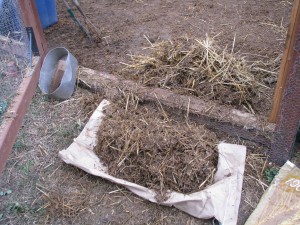
Good yucky straw. However the soil level in the raised bed has become lower, and the Bermuda grass has grown higher. Time for a re-do.
When I’d originally planted the bed a few years ago, I’d heard about burying wood to hold moisture and improve the soil. Some little thing we call… hugelkultur. I laid old lime tree logs along one side. They began to break down and some really cool mushrooms came up.
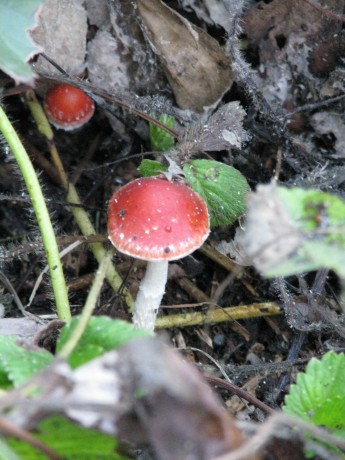
Cool mushrooms. Strawberries sent runners out and they rooted right in the wood. A great success.
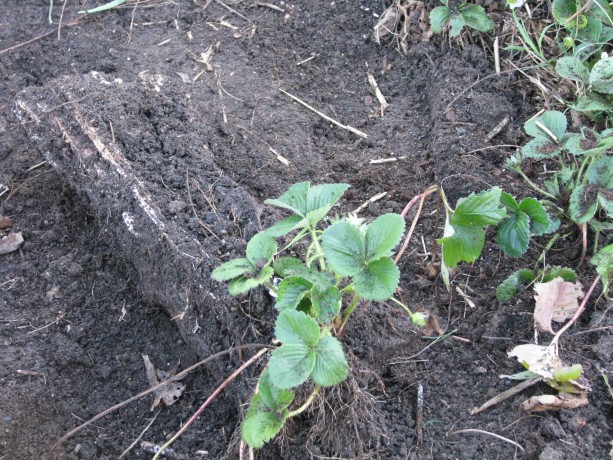
Strawberries rooted right in the wood! Since I don’t have ready compost to fill such a large bed right now, I decided to do the hugel-thing in the entire bed. I spent several hours digging out the strawberries and the Bermuda grass.
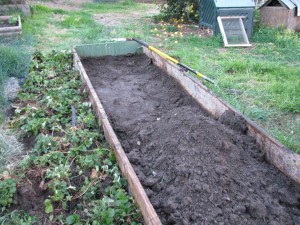
Making the bed: everyone out! Then I pulled the soil back and was simply amazed.
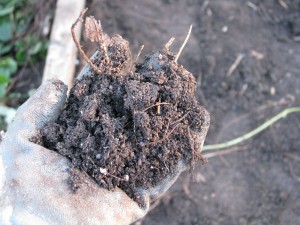
Beautiful soil It was crumbly like prime worm castings. I lined the bottom of the raised bed with the logs on top of the wire I’d laid across the bottom to deter gophers and mice.
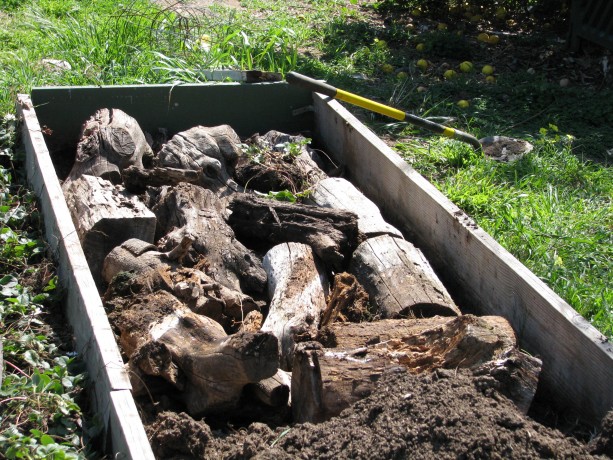
Old lime logs. Then I shoveled heavy clay out of the new bog area and threw that in and around the logs; the wood would decompose and turn the clay to great soil, and the clay already had a lot of interesting microscopic creatures in it from being at the edge of the pond.

Heavy clay. And I do mean heavy. On top of that I sprinkled some pigeon guano I recently received from some wonderful new friends who rescue pigeons. (They are wonderful even if they hadn’t given me the guano. I have many friends who, in fact, are guano-less. Just to clarify.) There were a lot of pigeon peas in the guano, but if they sprout its all good because they are nitrogen fixers and will only help things along. Some sugar was added to help stir up the bacteria in the clay.All along I watered everything in, including hosing down Lark the fat, barren Barred Rock hen who just wouldn’t take no for an answer and kept jumping into the bed to steal the worms!
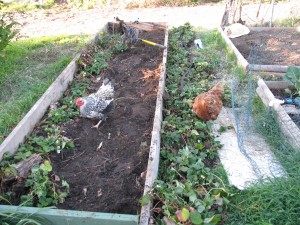
Get away from my worms, hens! My hens are such prima-donnas that they refuse to eat sowbugs and just go for worms. Geez! Lark got back at me later by making me come after her when it was time to shut them in for the night.
The last layer on the bed (and I don’t mean a chicken) was the good soil into which I replanted the strawberries. I did this process in thirds and ended up with a lot of extra strawberries.
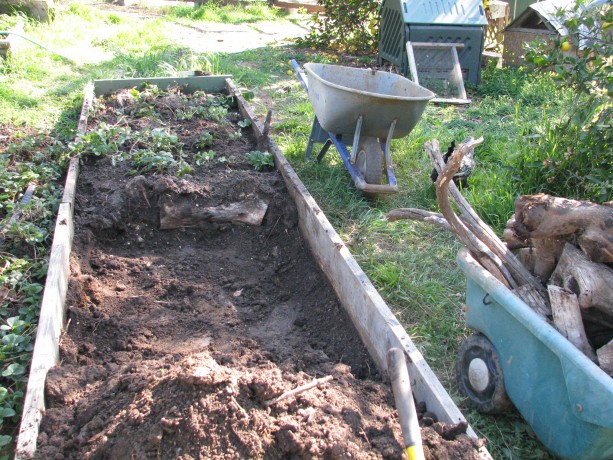
A third section done. As it was nearing sunset and I was becoming chilly in my shorts and sleeveless shirt, I hurriedly planted the extras up under the passionfruit trellis, in with the others from the previous planting. Most of them had happily survived.
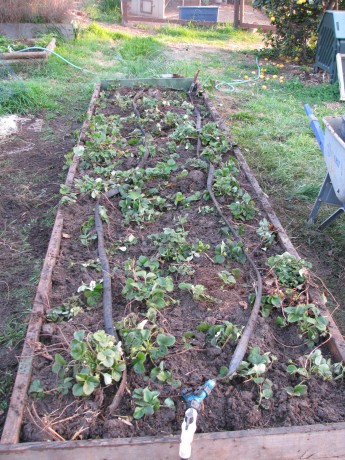
Finished! The leftover soil I sprinkled on top, laid the soaker hose back on top, and voila! A somewhat shocked but hopefully soon-to-be-happier strawberry bed.
There are a couple of wild mallards that come to the pond and have grown trusting of me up to a point. I throw game bird food by the pond for them. I don’t want to tame them, but I like it that they don’t fly off in a fright every time I come near. Its better for their health not to be so stressed. Makes me feel good, too.
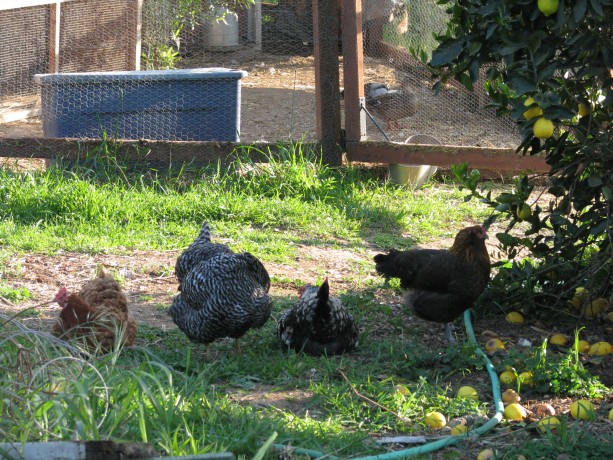
Hen line-up. But what is in the coop behind them? While I was digging I looked up to find my hens all in a row watching me, and beyond them inside the Fowl Fortress (the door of which I’d propped open) were the two mallards! They were perfectly content to be eating what the hens hadn’t eaten, and were even sitting in there enjoying… I don’t know… forbidden territory?
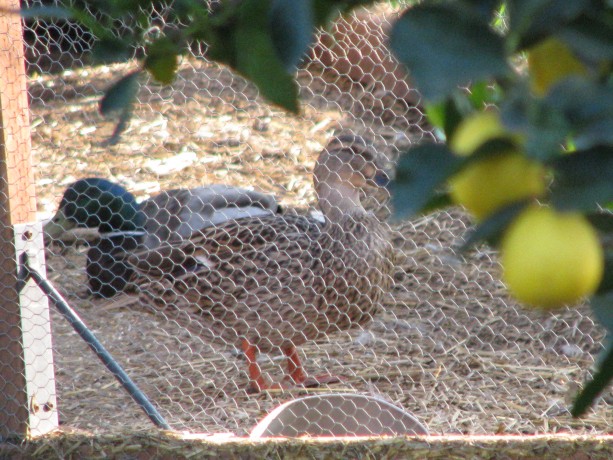
Just make yourself at home! The alluring and romantic smell of chicken poop? After awhile Miss Amelia wandered in there and the mallards wandered out. They’re welcome in there, but if they want me to build them a castle of their own, forget it. They already have the floating duck house, after all!
- Animals, Birding, Compost, Gardening adventures, Living structures, Permaculture and Edible Forest Gardening Adventures, Photos, Ponds, Rain Catching
Frost on the Pathways
It doesn’t often frost here in Fallbrook, which is located about an hour from both the mountains and the Pacific in northern San Diego county. When it does, the fruit growers have to take drastic steps to keep their citrus, avocados and other tender plants from dying. The last frost happened after a long steady rain, just after a thick mulch was applied to all the trails here at Finch Frolic Gardens (thank you, Lori!). I awoke to a magical result: just the pathways had turned white with frost. Beautiful! (You can click on the photos to enlarge).
Frost on the newly mulched trail. Between the two ponds. Ice skating rink for birds. Mr. and Mrs. Mallard enjoying some breakfast scratch. Sophie following the trail Little frosty bridge Past the new little bamboo bridge. Strawberries to Frost: “Bring it on!” These wildflowers survive frost just fine. Winter blooms, too! - Animals, Bees, Chickens, Cob, Compost, Composting toilet, Gardening adventures, Health, Heirloom Plants, Herbs, Natives, Permaculture and Edible Forest Gardening Adventures, Ponds, Rain Catching, Recipes, Salads, Soil, Vegan, Vegetables, Vegetarian, Worms
Southern California Permaculture Convergence! Be there!

Southern California Permaculture Convergence If you are interested in any aspect of permaculture, such as organic gardening, herbs, planting native plants, aquaponics, natural ponds, beekeeping, keeping chickens, and so much more, then you must come to the Southern California Permaculture Convergence. It happens on March 9th and 10th at the Sky Mountain Institute in Escondido. The keynote speaker will be Paul Wheaton, lecturer and permaculturalist extraordinaire of www.permies.com fame. Oh, and I’ll be one of the many speakers as well (cough cough). The Early Bird special of only $50 for both days ends at the end of January, and then the price will rise, so buy your tickets now!
Also, for a full-on demonstration of taking bare land and creating a permaculture garden, there will be a three-day intensive class taught by Paul Wheaton on site the three days prior to the Convergence.
You can read about the convergence here at the official website, which will give you the link perm.eventbrite.com where you may purchase tickets. Also visit the SD Permaculture Meetup page to see all the free workshops that happen monthly all over San Diego.
This convergence is such a deal, you really shouldn’t miss it! And such a bargain, too. One of the best things I find that come out of these convergences is the exchange of ideas and networking among the attendees, and all the practical information you can take home and use right away. One of the largest parts of permaculture is building community, which means sharing with and assisting others.
Really. Don’t miss this! Tell your friends!
-
Protecting Fruit

Strange fruit. We have many young fruit trees, including three figs. We have a Black Mission, a white and a Strawberry Jam fig. The trees are a year in the ground and not quite head-height, but all produce small amounts of fruit which ripen sequentially.
The birds know about the figs.
I’m glad to share a percentage of my crops with wildlife; this is a habitat after all, and there is more than enough for me and for sharing. However, there aren’t a lot of figs to go around. My daughter while home from University this summer took on a competitive attitude when harvesting the figs. She was out early testing for perfect ripeness, testing again as the sun set, being foiled by pecked fruit when it was at its peak of perfection.
Netting trees is not a good idea. The netting sits on the trees and the birds sit on it and peck through. Meanwhile it snags and sticks on the trees and is almost impossible to remove without doing damage to the trees. Also that plastic or nylon netting, if left on the ground, will often be deadly to beneficial snakes which become entangled in it (read about how I released one here).

Miranda came up with a wonderful, easy solution that re-purposed something of which we had plenty: plastic berry baskets. These baskets were hard enough to form a space around the fruit so that a bird couldn’t get its beak down through it. They also allowed air to flow around the fruit and sunshine in to ripen. They were also incredibly easy to quickly twist-tie onto the branch around an almost-ripened fig, and reposition to the next fig when it was time to pick the first one. The long twist-ties often used to hold heads of lettuces together worked best. Extra baskets were handy to put the picked figs into as well. This solution could be used for small grape clusters as well.

Obviously this solution is for small trees; but then, when the tree is large it will be producing plenty of fruit to share with the birds. Or, we can get a ladder and a lot of berry baskets and twist-ties.
That, however, may just cause talk in the neighborhood.
-
Jujube: a wonder tree

A handsome fruit. We mostly know the word jujube from having snacks as a kid in the movie theatre. Jujubes were once unchewable resinous candies of many flavors, and then were changed to something akin to gummy bears. Jujubes are a general term for a variety of candies in many countries. Oddly enough, and for reasons I know not, there is a tree called a jujube that bears wonderful fruit.

Jujube tree with fruit (a drupe, actually) ready to pick. Jujube trees (Ziziphus jujuba) have been cultivated in China for over four thousand years, and are gradually catching on in other countries. The first jujube fruit I ate was last year in a dried form. It was good, faintly reminiscent of a date. Now I have a tree that has just begun to bear fruit, and I am in love with it. The fruit is small, like very large olives. They begin green and then quickly turn to a reddish brown color, usually in blotches of color.

The fruit turns brown in patches, but can be eaten before completely dark. You can eat them fresh; in fact, I haven’t had them cooked yet. They are delightful. There is a center stone, such as in a date, but it holds two seeds.

Thin skin, crisp flesh like a green apple with a hint of date. The skin is thin and tender. The flesh is crisp and reminiscent of a green apple with hints of date. I love them. Many wait until the skin begins to wrinkle to eat them. You may pick the jujubes as they start turning color and they ripen quickly in the house without loss of flavor, or let them dry on the tree. Jujubes are high in vitamin C, and have been used medicinally in other countries, especially as a tea for sore throat. Best of all, so far the local birds ignore them, and there don’t seem to be any insect pests that love them.

Jujubes are a lovely reddish brown when ripe, and darken as they wrinkle. What makes the jujube a wonder tree is that it doesn’t seem to mind intense heat; in fact, it loves full sunshine and dry conditions. It also can survive a chill factor down to -28 degrees F! It doesn’t mind clay or alkaline soils, although good drainage and regular watering insures a good crop. They require little or no fertilization. There are many cultivars, the best being from China and more inferior ones from India and Japan. Many are thorny but some are virtually thornless. The trees can grow 30 feet high, have an attractive drooping appearance and are deciduous, the leaves yellowing before dropping. Suckers can appear several feet away from the trunk and can be controlled by mowing or pruning. You can read more about this remarkable tree here.
Why not try a jujube tree? They provide food, windbreak, mulch and have a very hard wood, and take just about any conditions. And the next time you go to a movie theatre you can bring your own jujubes… dried!
- Animals, Chickens, Gardening adventures, Heirloom Plants, Herbs, Other Insects, Permaculture and Edible Forest Gardening Adventures, Photos, Ponds, Quail, Vegetables
What’s Happening in the July Garden
A banana squash stealthily growing huge An apricot tree with fava beans, squash, herbs, artichokes, and tomatoes The withy hide growing beautifully Kabocha and delicata squash on the ground, zucchino rampicante on the trellis, Christmas beans, favas, Swiss chard and medicinal plants around a small avocado tree Favas: great for the soil, great for the dinnerplate Heirloom tomatoes. Why do they all come ripe at the same time? Sugar pumpkins are ripe already in the Mediterranean guild. Also figs, paste tomato, dill, fennel, thyme, pickling cucumbers and artichoke. Plant guilds of squash, beans, flowers, etc. are flourishing. Heirloom green melons hiding from the hot sun. By now the wild buckwheat has dried up, which starves the bees. But not here. Matilija and Flanders poppies over banana squash Monarchs are so plentiful this year that we have to take pains to avoid them. Wildflowers host an incredible diversity of insects Dill flowers looking like a spectacular firework In a balanced wildlife habitat, bunnys do little harm All five girls waiting for treats in the Fowl Fortress Pumpkins, bananas, bamboo and much more by fescue paths. Fresh grape leaves, dill and garlic from the garden for the pickles Hot weather? Must be canning season! Pickled cucumbers, zucchino and onions, and peach pit and peel jelly. Very large yellow waterlilies Native salt heliotrope by the big pond. Volunteer tomato in the shade of the Nest, by palm tree bench. Wisteria, grapes and zerpheranthum lilies around the Nest Blooming banana Quail eggs! Double heirloom hollyhock Egyptian lilies Fourth of July rose celebrating the holiday - Bees, Compost, Gardening adventures, Health, Heirloom Plants, Other Insects, Permaculture and Edible Forest Gardening Adventures, Soil, Vegetables
Integrated Gardening

Wildflowers, tasty borage, milkweed for the Monarch butterflies, and herbs. There are still those who prefer to have all their plants separate, each plant type confined to its own space. Vegetables should definitely not be allowed in the flower garden; herbs may be there only if more ornamental than useful, but don’t ever mix desert, country cottage or rose gardens together. That style of design is a matter of preference, and many gardens following those rules are very beautiful. They are usually also high maintenance, heavily fertilized, watered and sprayed, with poison set out for rodents.

A breadseed poppy is emerging in the sage. The blending of useful and ornamental plants is certainly not a new idea, and yet it isn’t often done. When it is, gardeners should find that the loss rate of plants to pests is quite low, and the yield of the vegetables is high.

Onions, native mallow, tarragon and sweet potatoes under a white fringe tree. Why is this? For one thing, planting mixed seeds which include ornamentals, herbs and vegetables masks the scent of the most yummy plants from its preditors. There aren’t rows of the same type of plant for the insects to find. Since different plants take up different nutrients from the soil, the soil isn’t depleted of one particular nutrient, so mixed plantings usually make for healthier and tastier plants.

My first tomatoes of the season, off of a volunteer along the pathway. Oh so yum! Wildflowers with cilantro, dill and basil not only are more successful and appealing to look at, but if let go to flower are excellent pollen sources for bees.

Young parsley, California poppy, cilantro and dill by rain lilies. Allowing desirable plants to reseed not only saves you money, but makes the new plant hardy and adapted for your particular garden.

Volunteers are welcome, such as this squash. Of course mixing plants is what an edible forest garden is all about, although the mixing isn’t random. Each plant serves a purpose. I use fava beans as a great edible nitrogen-fixer, along with other beans, peas, sweet peas, lupine, and nitrogen-fixing trees and shrubs. Artichokes grow quite large, and their leaves when cut and left on the ground make superb compost, as do the leaves of comfrey. Artichoke leaves keep growing back, and the plant will produce many very yummy artichokes. (Artichoke hint: wipe Vaseline around the stem below the bud to keep ants and earwigs from finding their way between the leaves.)

Artichoke and fava beans beneath an apricot tree. Melons and squash make an incredible ground cover during the hottest months. Their large leaves shade the soil surface and block evaporation. Remember that raccoons aren’t supposed to like going through squash vines, so plant them around your corn.

Green melon and corn by a variegated lemon (Sophie the dog by the car). Integrating your plants, especially when following the edible food forest guidelines, helps increase soil fertility (different plants remove different things from the soil). Mostly this is done by keeping the soil a more moist and inviting habitat for soil microbes and worms, but also by dropping their leaves which become mulch.

A guild: kabocha squash, heirloom squash and gourd (on wire) with onions interplanted to keep seedlings safe, along with something else that I don't remember planting, wildflowers, artichoke (under the milk carton for bunny protection), scented geraniums, lavender, borage, orgeano, sweet potatoes (not up yet), cowpeas, fava beans and Swiss chard by a small avocado tree. -
A Painless Breakfast, and a Bombilla
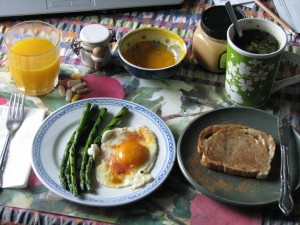
I'm all over this medicine! Food is the ultimate resource for health. As my body complains ever louder about all the years of abuse I’ve put it through, I’m turning to diet to help with the pain. Certain foods have anti-inflammatory properties, and they aren’t hard to eat at all. Cinnamon, turmeric, and ginger are high on the list. Cooked asparagus is excellent for kidneys and liver, and there is speculation that it cures serious illness as well. Whole eggs are much more healthy to eat than separating out the white and throwing away the yolk. The two parts compliment each other. As well great sources of protein, eggs are excellent for the eyes. The vitamin C found in fruit is an essential boost to your immune system, and helps other vitamins work better.
I also take some supplements. I take a multi-vitamin, a couple of natural menopausal relief pills, a vitamin C, and a couple of glucosamine/chondroitin tablets. G/C is a miracle supplement if you have arthritis. It helps keep the joints juicy.

Hot ginger tea; good for your tummy and good for your joints. So for mornings after a full day of weeding, carrying, hauling, flinging, and planting, I need everything I can get to help get my hands and back moving again. My ideal painless breakfast is: an egg from one of my hens, sprinkled with a turmeric and pepper combination (pepper is supposed to aid turmeric), some Trader Joe’s frozen grilled asparagus, heated, a piece of toast liberally sprinkled with cinnamon and coated with organic (sometimes home-harvested) honey, orange juice and a hot cup of ginger tea. I keep a small white container of cinnamon on the table, as well as a small bowl of the turmeric and pepper combination. That way I don’t forget to sprinkle it on my food. Inflammation is the source of almost all illness. If you can fight inflammation naturally, you’ll be a long way ahead health-wise. You’ll be relieved from pain that you never knew you had!

Bombilla I considered giving the bombilla its own post, but it was in the breakfast photo so I’ll talk about this wonderous gadget here. A bombilla is a metal or bamboo straw with a strainer on the end. Ingenious! Common in South America, it is commonly associated with the drinking of the new old fad tea yerba mate. However, to my delight it works perfectly with loose leaf and herbal teas! Instead of snapping and screwing and pressing tea strainers, I just put loose tea in my cup, brew it and drink it via the bombilla! So easy! Afterwards I scoop the spent tea into the compost, rinse the cup and the bombilla, and its good to go for the next batch. Loose leaf tea is such a better experience than using tea bags. With the bombilla, I now have herbal or loose leaf tea almost every time. Bombillas have transformed my drinking experience! I believe they are available at international marketplaces, but I bought mine online at Amazon.com. I bought two for me and my daughter, who took hers to college, and another as a gift for my son, and then two more as extras at home. Never can have enough bombillas! What a concept! A perfect drinking implement! My life will never be the same. Better still, I can now sip hot tea without losing my place in my book, or steaming up my glasses!
- Animals, Gardening adventures, Heirloom Plants, Permaculture and Edible Forest Gardening Adventures, Ponds, Reptiles and Amphibians, Soil, Vegetables
Earth Day at Finch Frolic
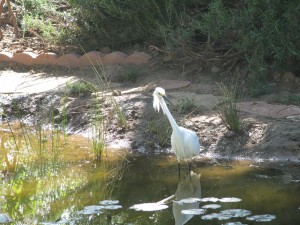
Snowy egret hunting. "Get the bullfrogs!" In celebration of Earth Day, I worked in the garden. You can stop laughing now. Yes, I know that I work in the garden nearly every day, and then spend time not volunteering or exercising, recovering from working in the garden. It was an overcast day, which beach-bound teenagers probably cursed, but I found perfect for working outside.

Roses in bloom everywhere. I had a visitor wishing me a Happy Earth Day.
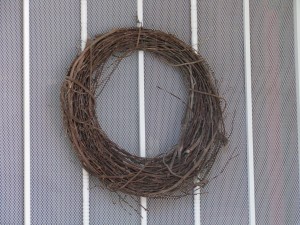
Do you notice anything about this wreath? This is an alligator lizard.
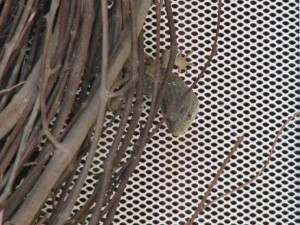
"Hello!" Hopefully he enjoyed the ride as I opened and closed the door several times to photograph him.
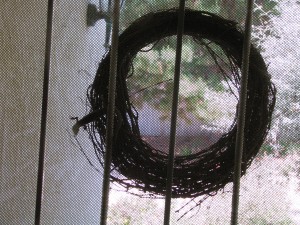
Alligator lizard from inside. Among other things today, I sifted compost. I had moved my compost bin, and this good compost was still on the ground from where it had been.
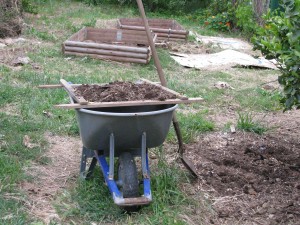
Sifting compost through a screen. I put it into a new raised (and wire-lined) bed.
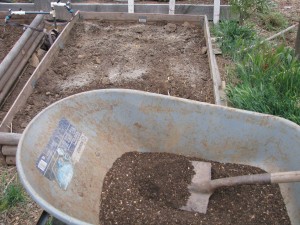
Adding sifted compost to the bed, which has been dusted with organic non-animal based fertilizer. Then I planted two rows of rice in it. Yes, rice. It is an heirloom variety from Baker Creek Organic Heirloom Seeds (http://rareseeds.com/rice-blue-bonnet.html), and it doesn’t need to stand in water to grow. Just something new and fun to try out.
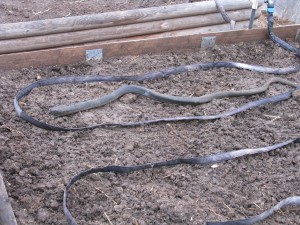
The rubber snake guards a freshly planted bed of rice. I’m also growing red seeded asparagus beans, the seeds of which were given to me by the woman who made the quail house. She also introduced me to Baker Creek, and for that I’m sincerely indebted. (http://rareseeds.com/red-seeded-asparagus-bean.html .)
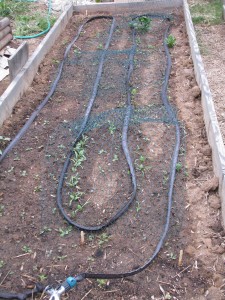
Spinach, carrots, edamame, sesame, Kentucky pole beans, endive and tomatoes are finally coming up. The other veggie beds are finally sprouting, now that the evenings have warmed up.
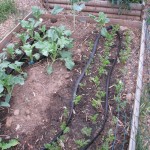
Collards and carrots, transplanted from another bed and doing well. 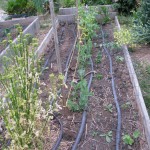
An incredible parsley setting seed, peas, parsnips, spinach, rhubarb, carrots and beans. 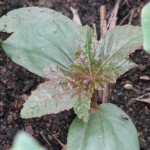
Castor bean seeds were in the mushroom compost, and I'm pulling them quickly. Here are a few views from other areas of the garden. Three weeds until the AAUW Garden Tour. Yikes!
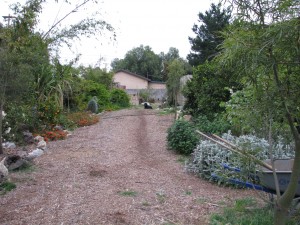
General Mischief waiting near the quail house for dinner. The hose connects to the 700 gallons of cootie water (compost tea) and is irrigating native plants. 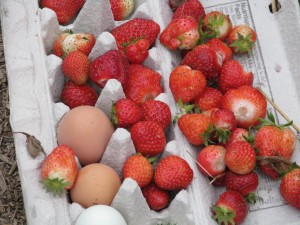
A happy harvest. Strawberries and eggs. I'm freezing the berries for later to make jam. 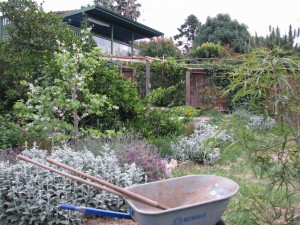
Lamb's Ear, whitebud, passionfruit and Bermuda grass 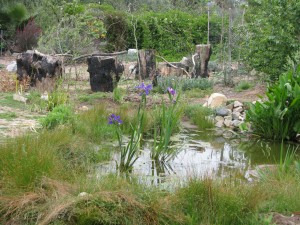
Stunning blue iris in the pond. 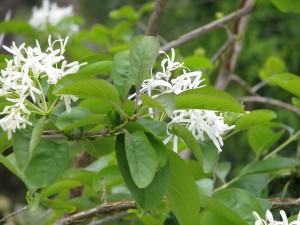
Fringe tree in bloom. 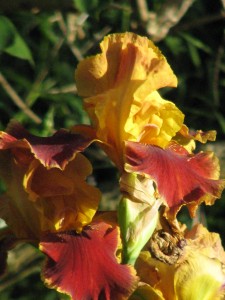
Iris -
What To Do With Grapefruit
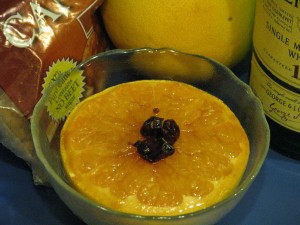
Grapefruit, all grown up. Every once in awhile someone gives me a grapefruit. One or two a year are just about all I can eat. Its not that I don’t like grapefruit. I certainly respect it. It is high is vitamin C and is supposed to be a good diet food. I think that is probably because it is so sour and bitter – even the pink kind – that you can’t taste anything else for hours after eating one.
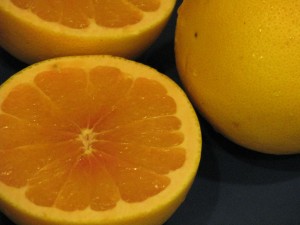
Bare naked grapefruit. My mother would serve us grapefruit halves. She had a set of grapefruit spoons I always coveted that had serrated edges, but they disappeared at some point and I’ve never seen any like them. The sharp edges would allow you to dig out the grapefruit sections without actually arm-wrestling with the fruit. She’d also often ‘section’ the halves, using a paring knife to cut each section free so that all we had to do was scoop them out. She left little reason for us to not eat them. Of course, not eating my mother’s cooking was unheard of anyway.
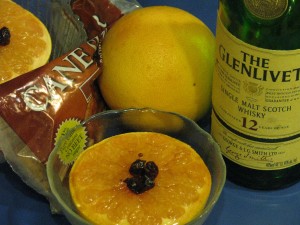
If you section the grapefruit first, you could probably get more whiskey in there. To make grapefruit much more appealing, she would doctor it up with brown sugar, whiskey and then broil it and serve it warm. Wow did that ever improve the taste! Since grapefruits are making the rounds right now, and no one else I’ve spoken with seems to have heard of this method of serving them (their ears sure perk up when I tell them, though!), I thought I’d do everyone a favor and print the recipe. The Grapefruit Diet suddenly doesn’t look so bleak.
Broiled GrapefruitAuthor: Diane C. KennedyRecipe type: SidePrep time:Cook time:Total time:Serves: 2This method of preparing grapefruit I learned from my mother, Beth Cywar, a fabulous cook and a nutritionist before her time. She also believed that food wouldn't do anyone any good if they wouldn't eat it.Ingredients- One grapefruit, cut in half widthwise.
- 1 - 2 teaspoons brown sugar
- 1 - 2 teaspoons whiskey
- A few fresh or dried berries (optional)
Instructions- You may section the grapefruit or not; your choice. Sectioning would probably allow more whiskey to seep in, and would be a little easier to eat, but it is optional.
- Place halves on foil or an oven-proof dish, or on a broiler pan.
- Start the broiler. A toaster oven works great.
- Sprinkle the grapefruit halves with the brown sugar.
- Slowly drizzle the whiskey over the halves.
- Broil until warm and slightly brown and sizzling, about ten minutes.
- Adorn with fresh or dried fruit, or if you want to be retro, a marashino cherry, and serve.

